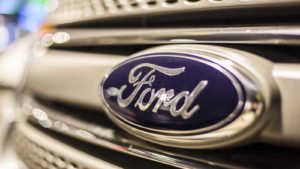Ford (NYSE:F) surprised Wall Street earlier this month with second-quarter results that were “way, way, way better than feared.” Ford stock jumped 4.3% on the news as investors rushed back in. According to Robintrack, Ford is now the most owned company by Robinhood investors.

But there’s a problem: Ford isn’t particularly profitable.
In the second quarter, the company actually lost $1.9 billion, bringing its 12-month return on capital to -2%. That should make experienced investors stop dead in their tracks. Not only is the firm’s mountain of debt a problem. History also shows that companies with low returns also make poor long-term investments. So even though Ford stock may pop 20% to 30% in the short run, here’s why investors should sell at $7 while they still can.
Poor ROIC Leads to Poor Returns for F Stock
Firstly, let’s put aside Ford’s cars and trucks for a moment. Instead, I’d like us to look under the financial hood for F stock.
Here’s why. Companies live (and often die) by a concept known as “return on invested capital” (ROIC). It’s a deceptively simple formula, which measures profitability over its debt plus equity capital. And it’s terrifyingly accurate: companies that earn low ROIC tend to underperform the market.
Over the past 10 years, the auto industry has lagged in generating ROIC. In part, that’s because auto manufacturers require huge outlays for their factories, creating a financial sinkhole on their balance sheets. In part, it’s also because market fragmentation makes the industry cutthroat competitive. Returns for the top six automakers by volume have consequently trailed the market.

These results matter. Over the past-ten years, NO major automaker has outperformed the stock market. And as Ford’s Q2 earnings show, there’s little hope for automotive companies to turn things around anytime soon. Despite having three significant product launches later this year, Ford’s management still warned investors to brace for an EBIT loss.
In other words, shares of automakers may *look* cheap, but that doesn’t mean they’ll ever be anything but cheap.

*Note: for those asking about upstarts like Tesla (NASDAQ:TSLA), Nio (NYSE:NIO) and Nikola (NASDAQ:NKLA), ROIC analysis works differently for pre-profit startup companies.
Ford’s Low ROIC Hampers Future Returns
Now back to Ford’s cars.
The company has continued to lose ground to foreign makers. In 2018, Ford dropped all but two car models from North America to focus on trucks and SUVs. Its U.S. market share now sits at 14.1%, down from 19% just seven years earlier.
The Michigan-based automaker has attempted to fight back. Ford plans to release the all-new Bronco in 2021 to compete in the off-road segment and release 40 electric vehicle models by 2022. On the production side, the company plans to cut platforms from 16 to five going forward.
But do these changes signal a watershed moment for the company’s profitability? Sadly not.
While other segments of the economy begin to recover, Ford has publicly stated that it expects “no meaningful change in the current economic conditions.”
Ford Has a Debt Problem
Investors looking deeper into Ford’s financials should prepare for even more bad news. That’s because the company has a lot of debt. In 2019, the firm reported $14.6 billion in automotive debt. And, while separate, it’s also worth noting that Ford Credit, its financial services arm, is $140 billion in debt.
Between 2017 to 2019, Ford generated $3.3 billion of interest payments for $8.6 billion of operating income, a coverage ratio of just 2.65 times. (General Motors (NYSE:GM), for comparison, had a 9.2x coverage ratio). And that was before the coronavirus pandemic cut sales by 50% in Q2.
How did Ford end up with such high debt? Though the company escaped bankruptcy during the 2008 financial crisis, the ordeal left the firm burdened with long-term charges that GM and Chrysler managed to shed in their Chapter 11 bankruptcies.
Despite having $42 billion in cash, Ford’s Ba2 junk rating from Moody’s, a bond ratings agency, reflects the automaker’s weak finances.
Ford Stock Is Cheap, But for Good Reason
Ford’s nightmare hasn’t ended yet. Moody’s expects Ford to burn through $8 billion in 2020 and another $3 billion in 2021. Its restructuring program will cost another $7 billion, leaving the company with a somewhat uncertain financial future.
And what about its automobiles? “Customer acceptance and Ford’s ability to earn an economic return on them are uncertain,” Bruce Clark at Moody’s writes. “Ford’s vehicle sales will be highly vulnerable to pronounced shifts in market sentiment and consumer demand in these unprecedented operating conditions.” In other words, Ford could fail simply because people like other cars better. Increasing competition from Indian and Chinese makers and upstarts like Tesla and other electric vehicle makers (EV) also won’t help.
The current F stock price of around $7 gives us just 9.4 times 2021 earnings (PE ratio), or less than half of the S&P 500.
But don’t be fooled. The simple metrics fail to capture the enterprise risk of their debt load. Its 20.8x EV/EBITDA ratio, for instance, is almost 50% higher than the market average (meaning investors are taking a significant gamble on Ford’s leverage). The average price target by 11 analysts come to just $7.56, with the most bullish posting only an $8.00 fair value.
Is Ford A Good Investment?
Ford’s financial and operating leverage means that good times may reward investors handsomely; a 1% improvement in operating income could bump net earnings by over 12%. But big rewards come with significant risks. Several more bad years could just as quickly land F stock in bankruptcy court and wipe out shareholders.
Investors looking into traditional automaker investments should consider less leveraged companies, such as GM or Toyota (NYSE:TM). Both companies are still down for the year but provide a far better risk-reward profile than Ford.
Tom Yeung, CFA, is a registered investment advisor on a mission to bring simplicity to the world of investing. As of this writing, Thomas Yeung did not hold a position in any of the aforementioned securities.
